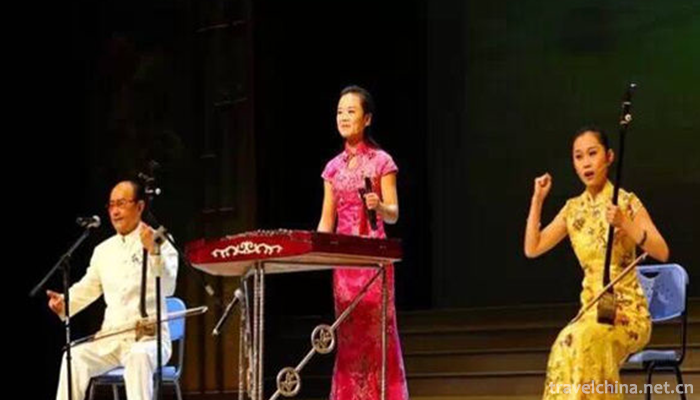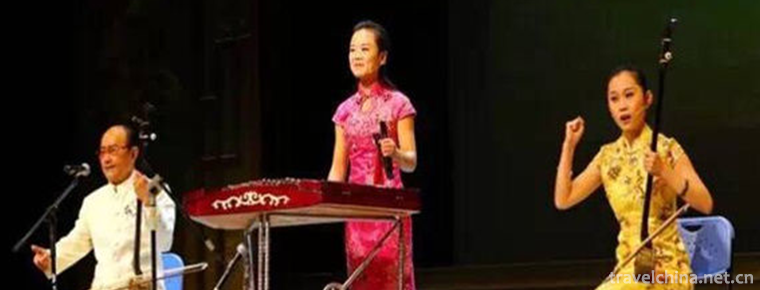Xuzhou Qinshu
Xuzhou Qinshu
Xuzhou Qinshu is a kind of opera recognized by Xuzhou local people in Jiangsu Province. Spread in Xuzhou. At first, it was a recreational activity of "playful friends" in the leisure time of farming in Xuzhou. People are playing dishes in the village yard, sitting around and singing and playing.
On June 7, 2008, Xuzhou Qinshu declared by Xuzhou City, Jiangsu Province, was approved by the State Council to be included in the second batch of national intangible cultural heritage list.
historical origin
Xuzhou Qinshu, originally known as Silk String, was accompanied by dulcimer in Qing Dynasty, so it is also called dulcimer. Xuzhou Qinshu was developed from silk strings. During the Tongzhi period of the Qing Dynasty, Li Yi, a Yangqin artist who worshiped Suiyan and moved to Suining County, became a teacher, introducing the art of Yangqin into the silk string. During the Anti-Japanese War, rich businessmen Jia Xingsan scattered and halls declined sharply; amateur playmates and semi-professional artists in rural and urban areas turned to professional artists in order to make a living. Their original "silk strings" in the melody of complex, rigid eyes, elegant and tame words, singing three sighs of more than 100 music licensing deletion and simplification, after many transformations, and finally formed a slow board and water board combined as the main body, a falling hu, a yangqin, "ninety-eighth tune seventy-two hey yo", to rap long repertoire as Master, and strengthen the use of hand, eye, body, law and other artistic means, the masses call it singing yangqin, and gradually formed a high-spirited, simple and dignified road (Fengfei, Pei, Xiao, Dangshan four counties), quiet and euphemistic, flowing colorful next road (Pi, Tongshan, Suning, Suqian four counties) different artistic styles.
During the War of Liberation, Qinshu artists in Xuzhou were organized by the people's government of the Liberated Areas to sing new songs to serve the revolutionary war. In the winter of 1948, with the development of the Huaihai Campaign, Qinshu artists gathered in Xuzhou from all directions. At that time, there were more than 80 performance venues and more than 500 famous artists performed. A lively scene of "piano sounds in the streets and lanes, adults and children can hum" appeared.
After 1949, it was renamed Xuzhou Qinshu by Xuzhou people. On the basis of Ming and Qing Xiaoqu, Xuzhou Qinshu evolved step by step from "Xiaoqu Er", "Xiaoqiaoer", "Singing Er", "Singing Child", etc. into a musical series and a combination of musical forms. Shandong has a unique charm when singing. Artists sit in the middle, mainly on Yangqin, pendant and hand board, equipped with three strings, soft bow huqin, zither, porcelain dish, etc.
In 1951, Xuzhou Quyi Team was established, and in 1953, it was approved by the Provincial Cultural Bureau as a privately-run public-funded Quyi group. The music troupe is mainly composed of artists who sing dulcimer, including Yang Sixi, Cui Jinlan, Cui Jinxia, Xing Peisheng, Ding Lanying and others. Later, twelve piano books were developed, which could be put on stage at the same time, and expanded into a musical troupe of more than seventy people.
Often performing in the vegetable market and other places, when there are temple festivals, there are many people singing piano books on the ground. It is welcomed by the people of Xuzhou. There was a grand scene of "piano sounds in the streets and at the end of the lanes, adults and children humming". It also affected the performance forms of piano books in Shandong, Xuzhou, with Xuzhou as the center, in various forms, including singing by one person, singing in pairs and singing by three people. Sit-in singing and multi-person singing, etc.
artistic characteristics
main features
The characteristics of Xuzhou Qinshu in the process of formation are as follows: the weakening of musicality and the strengthening of storytelling; the changing of musical cards; the changing of literary system from short to long; the changing of performance organization from big to small, and the strengthening of the use of artistic means such as hands, eyes, body and law. In the dialect used, due to the difference between the upper and lower roads in history, "going on the road" means "going up four counties" (Feng, Pei, Xiao, Dangshan), "going down" means "going down four counties" (Piao, Suining, Tongshan, Suqian). There are obvious differences in language between the upper and lower road. After a long time of accumulation, Qinshu also changes with the sound, gradually showing the different artistic styles of the upper and lower road. There are many singing methods on the top of "Shanglu" Qinshu, the words are heavy, simple and dignified, the eyes are regular, and the broken sections are extremely rare; "Xiglu" Qinshu mainly uses flash board singing method, and the words after the board are especially clear and melodious and fluent. The performances of Qinshu in Xuzhou are various, including singing, duet singing, sitting singing and multi-person singing. Singing is also very rich, in addition to the "four-sentence tune" and "chopping board" and other platforms, there are dozens of pieces such as "Overlapping Bridge", "Man Jianghong", "Upper River and Lower River Tune", "Ya Er Yo" and "Yin Niu Si". When an actor sings, he can freely use the words according to their content and sentence format.
Most of the traditional tracks reflect the lives of people in feudal society, but they depict the characters in the society at that time, reflect the people's beautiful ideals and aspirations, contain the essence of ideology and art, and reorganize and adapt traditional songs. The construction needs to proceed, innovate earnestly and create new works worthy of the times and with strong realistic color. Praise new characters, praise the new style of reform and construction, innovate in artistic form to a new realm, so that the original program through melting and creation and on the basis of a new life to extract a new program suitable for performing new life content, new means of performance. The piano books deeply rooted in the fertile soil of Xuzhou, weeding out the old and bringing forth the new, showing the hot real life, daring to explore and absorb the nutrition of sister art, will surely move towards a broader artistic world.
basic form
The basic sentence pattern of Xuzhou Qinshu is seven-character sentence, which can be added with three-character prefix and interlining. The main tunes are "Fengyang Song" (also known as "Four Sentences Cavity") and two kinds of pallets with different speeds and slows. In terms of artistic style, Xuzhou Qinshu on the North Road is exuberant and bold, while Qinshu on the East Road is quiet and euphemistic. Xuzhou Qinshu is basically the same as Shandong Qinshu in singing and accompanying instruments, which is related to Xuzhou's close proximity to Shandong.
"The sun rises in the West and falls in the east, the moon is a star, the sky is cloudless and it rains heavily..."
The melodious singing of an old man in Pengcheng Square has attracted many citizens. This is Wei Yuncai, a famous piano writer in Xuzhou, who risked the high temperature to publicize and sing the second batch of Xuzhou piano books listed in the national intangible cultural heritage. He hopes that Xuzhou piano books will receive more social attention.
Performing Form
The performances of Qinshu in Xuzhou are various, including singing, duet singing, sitting singing and multi-person singing.
Xuzhou Qinshu has a history of more than 300 years. It has a unique charm in singing. Artists sit in the middle and play the piano, accompanied by some people. Libretto originated from the daily life of the people, mostly for the family, so it was also called "the needle thread basket", and the traditional tracks handed down were "Zhang Yanxiu's examination" and "pig eight quit archway". The song he has just sung is called "Conversion", which is to invert the daily changes of the weather. He said that Qinshu is a traditional folk art originated and rooted in the folk, but at present, few people know and listen to Xuzhou Qinshu.
Inheritance Significance
Speaking of Xuzhou Qinshu, Wei Yuncai has two aspirations: First, the relevant departments can increase their concern and support, have a small theater, perform more, natural progress in skills, in order to attract more audiences and enter a virtuous circle. The second is to have successors and pass them on from generation to generation.
Xuzhou Qinshu, with a long history of more than 300 years, is juxtaposed with Suzhou Pingtan and Yangzhou Pingtan in Jiangsu Province. Its name derives from "Singing Er", "Singing Er", "Drawing String" and "Singing Yangqin". In the old days, folk artists used to make a living in the form of rap, in the streets and lanes, rural markets, open the stage can sing. Popular in Xuzhou, southern Shandong, Eastern Henan and northeastern Anhui, through Beijing, Shanghai and other local record companies to produce records and tapes and then spread to the whole country, loved by the masses.


-
1.Chongqing small noodles
Chongqing small noodles is one of the four characteristics of Chongqing
Time 2018-10-12 -
2.Serdang snow mountain Xiling snow mountain
Xiling Snow Mountain, located in Dayi County, Chengdu City, Sichuan Province, is only 95 kilometers away from Chengdu, with a total area of 483 square kilometers. It is a world natural heritage
Time 2018-10-30 -
3.Shapotou National Nature Reserve Ningxia
Shapotou: National AAAAA class tourist attraction, national desert ecological nature reserve, global environmental protection 500 best units, national fitness 20 famous landscapes, special prize for s
Time 2018-12-12 -
4.Guo Moruos Former Residence in Beijing
Guo Moruo's former residence is located at No. 18, Qianhaixi Rim, Xicheng District. Originally a garden in Heling in Qing Dynasty, it became the forage yard and stables of Yixian Mansion of Prince Gon
Time 2019-01-13 -
5.Kuqa Wangfu Scenic Area
Located in Kuqa County, Xinjiang, the "Kuqa Wangfu" was built by Emperor Qianlong of Qing Dynasty in 1759 by dispatching Han craftsmen from the mainland in order to commend the local Uygur l
Time 2019-01-29 -
6.Green Island Tourist Villa
Green Island Tourist Villa is one of the eight new scenic spots in Chaozhou, the national demonstration sites of leisure agriculture and rural tourism, the base of science and technology
Time 2019-02-06 -
7.Shuangrufeng Scenic Area
Guizhou Shuangrufeng Scenic Area is located in Zhenfeng County, Guizhou Province. It is 9 kilometers away from the county town and on the main road of Zhenfeng-Guiyang
Time 2019-02-08 -
8.Taoranting Park
Taoranting Park, located on the northwest side of Taoranqiao in the South Second Ring of Beijing, is a new modern urban garden, which integrates ancient and modern gardening arts and focuses on highli
Time 2019-02-13 -
9.Duodi dances
Multi-place dance, Tibetan folk dance, is a unique way for Tibetan people to dance and sing. It mainly distributes in three areas of Zhouqu County, Gansu Province
Time 2019-04-28 -
10.Fuzhou Reviews
Fuzhou dialect commentary is a unique traditional form of storytelling in Fuzhou dialect of Fujian Province, which is popular in Fuzhou, Fujian Hou, Yongtai, Changle, Lianjiang
Time 2019-04-30 -
11.Nail twist Jiaru jiacuo
Jiaru is a traditional dance of Mosuo people in Lugu Lake, Yunnan Province. It is a song and dance for people to celebrate harvest, festivals and pray for gods.
Time 2019-05-05 -
12.Cultural and cultural undertakings in Suining
By the end of 2019, there are 7 art performance groups, 6 art performance venues (including private), 6 cultural centers, 105 cultural stations and 6 Public Libraries in Suining City's cultural system. There are 1 national cultural industry demonstration base
Time 2020-12-16